The long-term impact that incorrect care can have on fish, even if they appear ‘fine’ in the short-term, can be quite significant. Unfortunately, most people often only discover this when the short term has become the long term and they are faced with problems, often not realising the origin of these problems. It can be quite tricky to find photos of fish that are suffering long term health problems caused by incorrect care as the deaths are often attributed to something else when many such fish die. Often though, this something else was actually the last straw and the death was due to a multitude of factors which can easily go unrecognised as they creep up over time.
A Tale of Four Goldfish was originally posted on the Practical Fishkeeping (PFK) forum in response to a thread about the impact of not keeping fish in the ‘perfect way’. The question was over whether or not it was all right to ‘make do’ if things were ‘going ok’. The original poster (OP) was very strongly taking the view that ‘well, I don’t do it by the book but my fish are ok’. ‘Ok’ is very subjective, and open to interpretation, as is ‘fine’. It’s not difficult to be lulled into a false sense of security when things appear, on the face of it, to be going ok in the short term. As the situation develops into the long term however, problems can come to light simply because the fish’s capacity to cope becomes overwhelmed, and the little acorns of problems that were sown in the short term grow into mighty oak trees of problems.
At the time I thought long and hard about posting on the thread, as it was already quite ‘lively’ with some very strong views being posted. But the more I thought about it the more I felt I had to say something; if poor practice and the advocating of poor practice are left unchallenged then as a hobby we risk failing the animals we claim to be so passionate about.
I felt I owed it to the fish whose life stories I was about to post to make sure that their experiences counted for something, and that somehow they could help other fishkeepers and other fish avoid the same heartache that we’d been through. It’s said that a picture speaks a thousand words and that is what I hoped my photos would do. The post proved rather popular, and one of the moderators very kindly made a sticky of it so it would stay at the top of the forum and help spread the message. The PFK forum has since closed, and the only other place this post lives is one other forum, fishkeeping.co.uk. I’ve added it to INJAF so that others can see it and learn from the experiences of these four fish. Below is exactly what I originally posted, with a few additions (in italics) to provide more detail. I did think about re-writing it but I wrote it very much from the heart at the time and I wanted to keep that. Further on are examples from other species as it’s not just goldfish affected by this.
A Tale of Four Goldfish
My other half had a common goldfish when we met as students. OH is not the sort to randomly buy pets, he always finds out about things first. Fishie was bought in 1991, the internet was nowhere near what it is now so books and information from shops were the source of reference. Fishie had a 40 litre tank – 40 litres for a goldfish – that’s what was (and sadly sometimes still is) commonly recommended. We thought this was fine, eventually though we thought he could do with a bit more room so bought him a 70 litre tank, nice and big we thought. He started having health problems as he got older; we turned to the internet for help and soon found out what was wrong. Too small a tank, stunted fish, poor diet, lack of understanding of the nitrogen cycle, Fishie was a common – these should be in ponds not tanks – something of a catalogue of errors.
(This was around January 2006, I joined a couple of forums and was fortunate enough to meet some good people who were already busy advocating ponds for commons, and big tanks for fancies. That was 12 years ago and while we’ve come a long way as a hobby in those 12 years there is still much to be done, those voices that were speaking out 12 years ago are still going, and they’re starting to be heard.)
We sorted out the tank as best we could at the time and got him a four foot, 350 litre one (arguably nowhere near big enough) but it was too late to really sort out the health problems we’d caused him. He was blind as well as the problems mentioned above. Blind because he developed a bacterial infection from living in a half cycled, too small tank where pollutants built up to dangerous levels. His immune system was non-existent in his latter years, a result of poor diet, stunting and associated ill health from being kept in less than perfect conditions for most of his life.
Below are some pics, the first one is Fishie, it’s not pretty is it.
Fishie
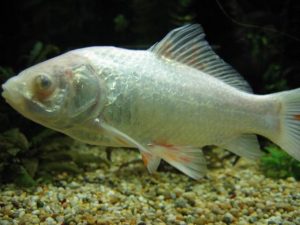
This is how he looked towards the end of his life, skinny (his digestive system was hopeless), blind, suffering yet another infection despite the UV sterilizer and trips to the vet. But he was 17 when he died, he would take food from my hands, he swam about, reacted to noises about the tank and as far as was possible interacted with me and OH. So does that mean he was happy and his life was a fishkeeping success? I guess he could have been less happy but I’ll be honest and say he could have been a heck of a lot happier. He lived a long time but you can’t judge the success or otherwise of keeping a pet by how long it lives, there are many variables to take into account. The second pic is Howie, another of my fish. Howie is there to illustrate what Fishie should have looked like. Bit of a difference. (Howie was about 11 years old here)
Howie
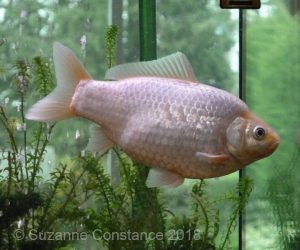
Plenty of people who came to our house commented on Fishie over the years, “isn’t he big” (um, no, not really, he was stunted) “what a lovely big tank” (um, no, not really, it was only 70 litres), “doesn’t he look healthy” (um, no, not really, he was blind and stunted). People said nice things about him and his tank but this didn’t mean they knew what they were talking about, or that he was healthy and had the right tank. (This was to illustrate that just because someone says your tank and fish look great it doesn’t mean they really are! Judging success by the comments and compliments of well meaning but poorly informed people is not a safe means of assessment. If you had a vintage car would you judge the safety of the brakes and steering by the fact that someone with no knowledge of mechanics had said the paintwork looked good?).
Second example is Jerry, a comet. Jerry was kept in a bowl and then a 30 litre bowl-shaped tank for four years.
Jerry
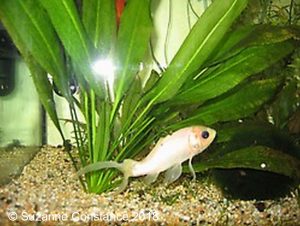
When he came to live with us he was, at four years old, the size a healthy comet ought to have been at about four months old. Malnourished, stunted, deformed, he died three months after he came to us. His body was too damaged for recovery and his systems just failed. But his previous owners could not be persuaded there was anything wrong with him, he got excited at food time, he ate, he swam about, his water was changed, he had a filter, their friends commented on how nice the tank and fish looked. “After all, goldfish live in bowls don’t they so a nice bowl shaped, filtered tank has got to be luxury hasn’t it? And he’s four years old? Gosh, I had no idea they could live so long.” People said nice things about him and his tank but this didn’t mean they knew what they were talking about, or that he was healthy and had the right tank. Compare his pic to the fourth one, a wakin/comet, another of my fish. Pixie is about the same age here as Jerry was when he died, spot the difference.
(Jerry’s tail was strangely deformed and kinked upwards as a result of constantly swimming in circles gasping for breath at the surface. He was tiny and very skinny, you can see from the disproportionate size of his head that he was a very poor shape. Jerry spent his last three months living alone, I’d always hoped he might get strong enough to join the others in the bigger tank but he never did. He was never strong enough to compete for food and he could only eat a very limited diet without suffering buoyancy problems, not something often seen in a comet, they can usually eat anything and everything without so much as a sniff of a problem! So sadly he never got to have the social life that goldies benefit from, but he did get to live out his final days in peace and comfort.)
Pixie
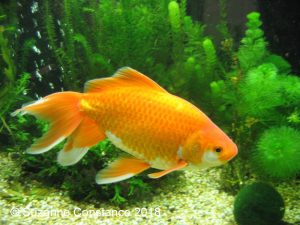
You may have noticed that my healthy examples live in tanks, not the ponds they should ideally live in. These two are ones I rehomed from far less suitable conditions. Would I have bought them? No. Would I improve their outlook by offering them a home more suitable than their original ones? Of course. In case anyone was wondering, the two tanks we have now are 6’7″ and 550 litres. That’s not me having a ‘look at me and my big tanks’ moment, it’s just a point of information.
(Howie and Pixie came from homes where they were very much cared for, but their owners learned that the fish needed more than they were able to provide and tried to find them somewhere they could have more room to swim and be able to live with other goldies. Taking them in wasn’t an easy decision as I knew they would ideally need more than even these big tanks could provide. However, Howie was over 10 years old, had never lived outside, never been through a winter, utterly clueless about predators (he would have gone to see what the cat wanted!) and we were concerned that finding him a pond might just end up killing him with kindness. Pixie was tiny when he first came, a very very nervous fish who doted on his fancy companion that came with him. He often hid under her tail when he was tiny and something made him jump, this became less successful as he grew and he just looked like he was wearing a rather annoyed hat! He may have been ok in a pond but it’s likely his very long flowing tail would have suffered in the winter as lack of circulation can result in damage to the extremities in the cold. Again, it was decided not to risk him going to a pond. Taking them on was a pragmatic approach to a situation where the fish were already in need.)
The point I’m trying to make is that we thought we were doing all right by Fishie, Jerry’s owners thought they were doing all right by him. This wasn’t the case and their ill health was the result. So the ‘rules’ and guidelines are there for a purpose, to help stop people like me inadvertently inflicting ill health upon their pets. If caresheets and general consensus say a fish needs X to thrive then there’s a reason for that. Like Fishie and Jerry it can live in less than X and not die but take a look at the photos, imagine how I felt when Jerry died at four years old and there wasn’t a thing I could do for him but watch him lying there and wonder if this time maybe he wouldn’t come back from the dead. Imagine how we felt looking at Fishie in that state and knowing we were responsible for that. I could argue that Fishie was ‘ok’ for years. Look at how he ended up though. And we did everything we could to help him once we realised where we were going wrong, wasn’t enough to make his final years a healthy and successful experience for any of us.
It’s not really about keeping fish on a particular budget, or fitting the ones you want to keep into your own life but not having massive tanks perfect for a particular fish and persuading yourself it’s ok. Or about posting on forums being controversial/looking for validation and absolution. If you provide only what they need in order to survive you’re in danger of ending up with a Fishie or a Jerry. We got it wrong for Fishie and I’m happy to hold my hands up to that, I would be a fool to do otherwise. I really hope that this helps stop other fish suffering the same fate as F & J.
It’s not only goldfish though …
The original post ends as above. But it’s important to make the point that it’s not only goldfish that suffer health problems, stunted growth etc., it can happen to any fish. The photos below were posted on the PFK forum a little while after the above. The poster had rescued the two fish from very poor conditions and shared the photos for help and advice, but also to show the results of poor care on these fish. It’s thought that these are not young fish, but with their murky past it was hard for anyone to be sure. Fortunately their owner had realised they needed to be rehomed. They are two common plecs, Pterygoplichthys pardalis, believe it or not! They’d been kept in a very small tank and had developed significant deformities as a result. Photos courtesy of BettaQueen on PFK forum.
Stunted Pterygoplichthys pardalis (aka common plec)
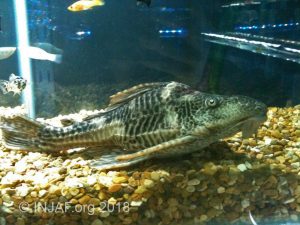
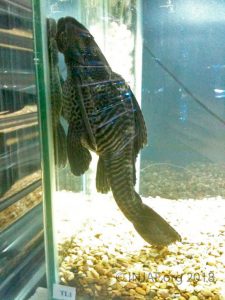
Hermione is also a Pterygoplichthys pardalis, she’s an albino so lacks the markings of these two but at about 16 inches long she demonstrates what the two shown above should have looked like. You might also like to check out the photos of this species on planetcatfish as they have some with the same colouring as the two above. The difference is quite something.
Hermione
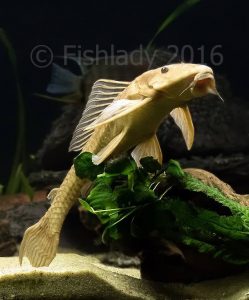
Hermione is a rescue fish herself. She was rescued from the small, grotty tank in the photo below (where you can just about see her trying to hide behind the heater on the left) when the business premises she lived at were closing down. She’d been threatened with ‘the flush’ but a knight in shining armour stepped in and saved the day (and Hermione!). Since then she’s blossomed and grown and is now the stunning girl in the other photos.
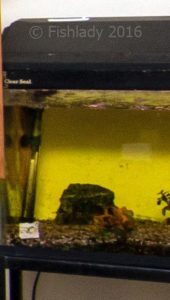
You can get an idea of her size from the fact she’s eating a large brussel sprout!
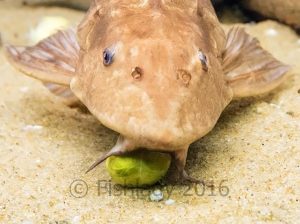
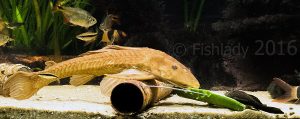
We think she’s a stunner and a great example of what ‘common plecs’ should be looking like. They’re so often sold to live in too small tanks, ‘cleaning the algae’ – that’s not the life they should have, this is the life they should have – big tanks, good food and lots of TLC.
Jethro & Gibbs (and a happy ending)
The story of Jethro and Gibbs was posted on the PFK forum in 2013 by the lady who’d rescued them. She wanted to use their story to help educate others and show how unsuitable these big fish were for the average aquarium, and how they’re often bought as algae eaters when really their needs are significantly above and beyond that. This is their story, updated five years later to show that sometimes fish can come back from the edge if they get the care they so desperately need. Jethro and Gibbs are two Pterygoplichthys gibbiceps.
A plec is for life, not just for algae
This is the story of my two plecs, Jethro and Gibbs. It started with bidding and winning a tank on eBay, the description stating that the fish would be rehomed. It was not big at 36”x12”x15” – I wanted it as a quarantine tank. I got a phone call from my husband telling me that the person had not rehomed the fish and they were “ruddy big things”. The owner said they would stick them in a bucket and take them to a shop in the morning but we felt it best to bring them home.
He had to transport the fish in the tank, half filled with water. When they got here I could smell the tank before I saw it! I was horrified to see two huge plecs, one 14” the other 12” inside. My plans for my Juwel Rio 300 went straight out of the window and we filled it up and put the two fish in. The tank came with an external filter which was not working properly but I got it running, added some media from one of my other tanks and connected it to the Rio.
Both fish were skinny and for weeks seemed to ooze gunk from their skin. Jethro also developed blackened ends to two of his fins, the lack of space in his old tank meant he had been rubbing against the ornaments in an effort to move about, taking off skin down to the bone which was exposed and infected. Under advisement from a fish expert, we used clove oil to knock Jethro out and clipped off the dead bone and tissue and covered the exposed ends with sudocrem. It worked and new tissue began to grow over the exposed bone. It left Jethro with slightly shortened fins, but it does not bother him.
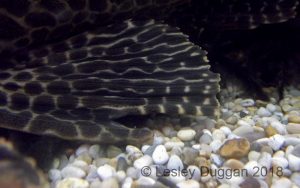
Jethro and Gibbs stayed together in the 300 litre tank for six months to make sure they were both well and starting to get nice rounded bellies instead of horribly sunken ones. I then started looking for homes for them and it then dawned on me just how many of these beautiful fish are given away because they are unwanted, too big for the tank, no longer eat algae and make a huge mess. I sat one evening by the tank, tears on my cheeks, when Hubby came into the room smiling at me. I asked him what I should do with my boys, no one wanted them and their temporary home was too small and he said “I’ve just bought you a bigger tank”. Jethro and Gibbs were staying!
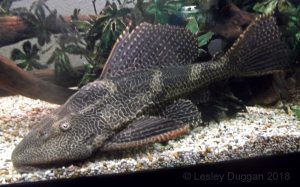
The original post ended as above, but we’re happy to report that five years on Jethro and Gibbs are still with the lady who won their tank on eBay. Both have grown and Gibbs is now 18″ while Jethro is 20″. As you can see, they are huge fish and looking very well these days.

The long term impact of their previous life could have been huge, and they do still bear the scars, quite literally. Fish have an amazing will to live, and with the right care and attention even those on the very edge can sometimes come back. We wanted to end on a positive note, and to encourage people to do the right thing by the animals in their care because it does pay such huge rewards.

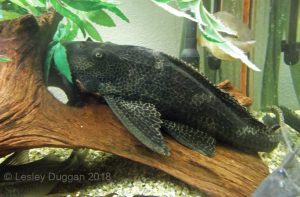
We hope our experiences and photos can be used to help others avoid these problems so please do feel free to share them.
Further Reading
Do fish grow to the size of their tank?
Tankbusters
Adult sizes of popular fish species
Tropical fish to think twice about
Pterygoplicthys pardalis: PlanetCatfish profile
Pterygoplicthys gibbiceps: PlanetCatfish profile
A-Z of Fish Health: Part 1, A-E (Practical Fishkeeping)
A-Z of Fish Health: Part 2, F-L (Practical FIshkeeping)
A-Z of Fish Health: Part 3, M-R (Practical Fishkeeping)
A-Z of Fish Health: Part 4, S-Z (Practical Fishkeeping)
Find a fish vet (OATA)
Please also check out the articles in our Goldfish section under Aquarium Fish.
Author: Suzanne Constance, the story of Jethro and Gibbs written and contributed by Lesley Duggan.
Photos courtesy of: Suzanne Constance, Fishlady, BettaQueen and Lesley Duggan.




